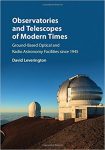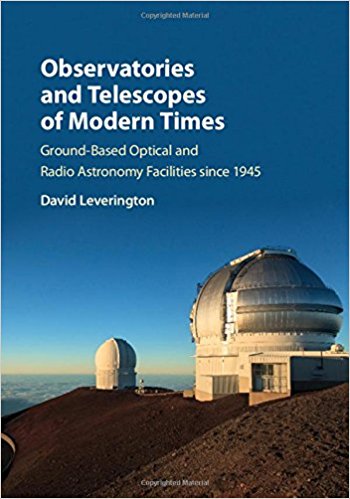 Author: David Leverington
Author: David Leverington
Publisher: Cambridge University Press – 490 pages
Book Review by: Sonu Chandiram
This book provides a history of optical/infrared and radio/microwave telescope facilities around the world from 1945 to 2017. It also includes broad coverage of the most innovative and trend-setting technologies. Among the matters discussed in this volume are:
- Financial and political factors that encouraged, as well as constrained the building of these facilities
- People involved in their development
- New technologies that improved space observation, e.g. active and adaptive optics, charge-coupled devices (CCDs), and spun honeycomb and segmented mirrors
- Development of radio astronomy facilities such as the ALMA (Atacama Large Millimeter/submillimeter Array) at 16,000 feet altitude in Chile
This latest book by David Leverington – a knowledgeable space physicist who worked with British Aerospace (later renamed BAE Systems) and the European Space Agency, and is the author of four other books – provides extensive coverage on the subject of space observation and exploration. It also provides various construction and project development details that led to the construction of the observatories named below.
This text is a companion to the author’s previous work New Cosmic Horizons. To give you a broad overview of its contents, we provide you below a list of its 24 chapters:
- Part I. Optical Observatories
- Palomar Mountain Observatory
- The United States Optical Observatory
- From the Next Generation Telescope to Gemini and SOAR
- Competing Primary Mirror Designs
- Active Optics, Adaptive Optics, and Other Technical Innovations
- European Northern Observatory and Calar Alto
- European Southern Observatory
- Mauna Kea Observatory
- Australian Optical Observatories
- Mount Hopkins’ Whipple Observatory and the MMT
- Apache Point Observatory
- Carnegie Southern Observatory (Las Campanas)
- Mount Graham International Optical Observatory
- Modern Optical Interferometers
- Solar Observatories
- Part II. Radio Observatories
- Australian Radio Observatories
- Cambridge Mullard Radio Observatory
- Jodrell Bank
- Early Radio Observatories
- The American National Radio Astronomy Observatory
- Owens Valley and Mauna Kea
- Further North and Central American Observatories
- Further European and Asian Radio Observatories
- ALMA Observatory in Chile and the South Pole
As a brief refresher point on those who may not remember from their astronomy class, an optical telescope is basically a device that gathers and focuses light, mainly from the visible part of the electromagnetic spectrum, to create a magnified image for direct view, or to make a photo, or to collect data through electronic image sensors. There are three primary types of optical telescope:
- Refractors, which use lenses(dioptics)
- Reflectors, which use mirrors(catoptrics)
- Cardiooptic, which combine lenses and mirrors
A telescope’s light gathering power and ability to resolve small detail is directly related to the diameter (or aperture) of its object (the primary lens or mirror that collects and focuses the light). The larger the object, the more light the telescope collects and the finer detail it resolves.
In going through an article on Wikipedia that lists the largest and most powerful optical reflecting telescopes on earth, we found that the two main features to consider are the diameter of the mirror and the aperture, which determines its light-gathering power.
“Optical aperture has historically been a useful gauge of limiting resolution, optical area, physical size and cost,” the article author writes.
Ranked by optical aperture, the largest reflecting telescopes in the world today are:
- Gran Telescopio Canarias (GTC) in the Canary Islands in Spain, with an aperture of 409 inches, built in 2009, built in joint cooperation among Spain, Mexico and United States
- The Hobby-Eberly Telescope (HET) at McDonald Observatory in Texas with an aperture of 394 inches built in 1997 built in joint cooperation between the U.S. and Germany.
- The Keck 1 and Keck 2 telescopes, both with apertures of 394 inches, at Mauna Kea Laboratories in Hawaii, USA, built in 1993 and 1996 respectively
- The South African Large Telescope (SALT) with an aperture of 362 inches, at South African Astronomical Observatory South Africa, built in 2005.with joint cooperation among South Africa, the United States, the United Kingdom, Germany, Poland and New Zealand.
- Large Binocular Telescope (LBT) at Mount Graham International Observatory in Arizona, with an aperture of 330 inches, built in 2004 with joint cooperation among the United States, Italy and Germany.
- The Subaru Telescope at Mauna Kea Observatories in Hawaii, USA, with a aperture of 323 inches, built in 1999 by Japan.
- Four other telescopes, all with apertures of 323 inches. have been built at Paranal Observatory in the Antofagasta region of Chile, built in the years 1998-2001, jointly by Chile and the 16-member European South Observatory (15 European nations and Brazil).
A radio telescope on the other hand receives radio waves, whereas an optical telescope receives light waves. A radio telescope is a very highly specialized antenna and radio receiver used to receive such waves from astronomical radio sources in the sky.
Radio telescopes are the main observing instrument used in radio astronomy, which studies the radio frequency portion of the electromagnetic spectrum emitted by astronomical objects, just as optical telescopes are the main observing instrument used in traditional optical astronomy which studies the light wave portion of the spectrum coming from astronomical objects.
This history of space observatories is an important, rare, and useful work in the limited literature of such books. When we look back in the future to understand how observation space led to space exploration, we’ll able to thread together the various events initiated by the courageous and pioneering actors that paved the path and led the way.
With this book, Leverington has made a significant contribution to our understanding of space.
Author:
David Leverington received his first degree in Physics from Oxford University in 1963. Since then he has held a number of senior positions in the space industry, working for both the European Space Agency and the British Aerospace (now BAE Systems) before taking early retirement in 1992.
Subsequently he has written four books: A History of Astronomy from 1890 to the Present, (Springer Verlag, 1996), New Cosmic Horizons: Space Astronomy from the V2 to the Hubble Space Telescope (Cambridge University Press, 2000), Babylon to Voyager and Beyond: A History of Planetary Astronomy (Cambridge, 2003), and Encyclopedia of the History of Astronomy and Astrophysics (Cambridge, 2013).
He was also technical consultant for ABC-CLIO’s Space Exploration and Humanity: A Historical Encyclopedia (2010) supported by the History Committee of the American Astronautical Society. He was awarded his PhD in 1997.







